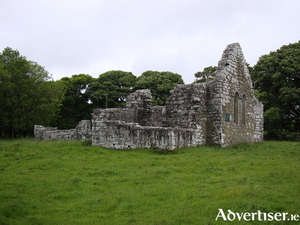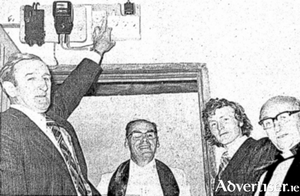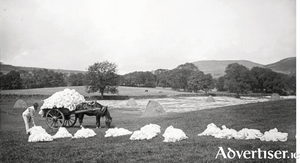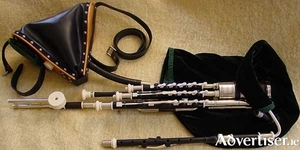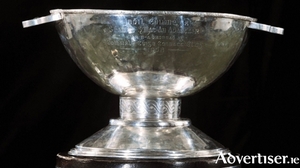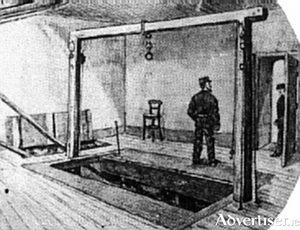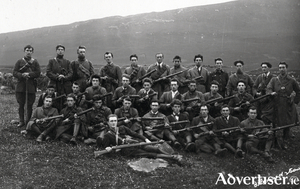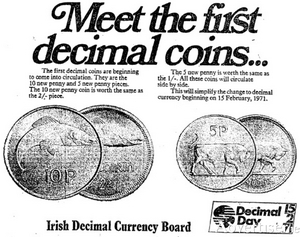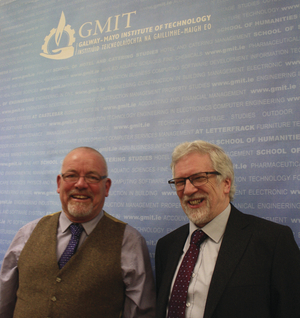A sheriff once roamed these here parts
Fri, Jul 21, 2017
The High Sheriff of Mayo was the British Crown’s representative in the county from the post’s creation in 1583 until the establishment of the Irish Free State in 1922. In a country where ownership of land carried huge prestige, the landed had to protect what they held by securing positions of power. So it was in County Mayo that the dominant families of Browne, Bingham and Gore isolated the role of High Sheriff largely for themselves up until the 19th century at least, from which time family names such as O’Donel, Knox, Blake and others appear in the records as holders of the office.
The High Sheriff was the principal representative of central government in the county in relation to the execution of the law. The position developed to include selecting the county grand jury (a precursor of the county council) and supervising parliamentary elections. In the early decades of the 1800s polling took place over a number of days in one location in the county. Under the Reform Act of 1832, five days were allowed for Irish county elections. This was reduced to two days in 1850 and finally one in 1862. Making sure elections ran unhindered was a large undertaking for the High Sheriff and the military. It was estimated that in 1832 two-thirds of the total military force in the country was employed on election duty. Contested elections could all too easily turn riotous. In January 1835, the High Sheriff of Mayo, JN Gildea, wrote to the Under-Secretary for Ireland explaining that due to the many attacks at the last election, he was suggesting that ‘three troops of cavalry, and five of infantry, together with the police, will not, in my opinion, exceed that which may be required to protect freeholders, and keep the peace’.
Read more ...The history of Lough Mask through its own isles
Fri, Jul 14, 2017
Throughout the centuries the islands of Lough Mask have stood silently and helplessly by as they played host to many extraordinary events. This week I am able to touch on just some of those events chronologically.
Read more ...The Protestant enclave of Inishbiggle
Fri, Jul 07, 2017
In the 1650s, Catholics were uprooted from their productive, arable, lands in several Irish counties by Oliver Cromwell’s Protestant army and forced at musket point to desolate, barren, Connacht. Their confiscated lands, the better holdings in Ireland, were distributed to Protestant settlers, Cromwell’s army as pay, and carved up to pay debts. Maps of Ireland, pre and post Cromwell, detailing the regression of the predominantly Catholic associated Irish language and customs point to a culture that was deliberately and officially forced to areas thought of as being so inhospitable they would not survive. County Mayo was included among these religious and cultural ghettoes. The living standards of the banished Catholics fell dangerously low and remained so for centuries. Christian duty led some within the Protestant clergy to later establish evangelical missions in the wild Irish west to give relief to the descendants of those very same Catholics. Salvation and, dishonourably, food were offered through conversion to Protestantism. Whereas 17th century Protestants believed it was God's will that godless Catholics be sent to suffer and perhaps perish in Mayo, 19th century Protestants believed it was His will that these (still godless) Catholics be reclaimed so that they might be saved. The Rev Edward Nangle's Achill Island Mission set out to do just that in 1831.
Read more ...North Mayo’s flax growing industry
Fri, Jun 30, 2017
The success of the early linen industry in Mayo is often overlooked, especially in terms of the numbers it brought into regular employment. The growing of flax in Ireland for the production of linen was encouraged by English monarchs from the 17th century in order to reduce the Irish woollen industry which was competing with its English counterpart. The Crown's chief governors in Ireland supplied flax seed, sold looms at cost to farmers and employed linen experts from the continent to instruct the Irish in how to get the most from their flax harvest. The industry exploded as a result, and by the end of the 1700s, linen accounted for almost half of Ireland's total exports. Mayo benefited greatly from the linen boom. The Binghams of Castlebar and Brownes of Westport developed massive linen markets in both towns. Castlebar catered for all linen trading from the south of the county. By 1834, 30,000 people were employed in the linen industry in Mayo. That equated to over eight per cent of the county's population which had increased in tandem with the growth of the linen trade.
Read more ...Celebrate our maritime heritage this summer
Fri, Jun 23, 2017
Off the longest county coastline in Ireland, around scores of islands, as many lakes and along 100 rivers, the inhabitants of Mayo have taken to their boats and exploited our county's waterways in a sustainable manner for hundreds of years. That strong heritage is etched on our crest and is alive and celebrated today. Irish traditional boats in general took on distinctive regional characteristics and the designs of crafts were shaped by purpose, available materials and historical circumstances. Because of our geographical size, Mayo has been a focus of academics studying our many contributions to traditional boat typology.
Read more ...Mayo’s role in saving the uilleann pipes
Fri, Jun 16, 2017
Happy first birthday to Old Mayo. The first article appeared on June 17 last year. This week’s offering, the 52nd article in the series, focuses on Mayo’s role in aiding the survival of the uilleann pipes. This not particularly old but peculiarly Irish suited instrument with its smooth, haunting, sounds has drifted from popularity to a precarious state and back.
Read more ...Come back Nestor - All is forgiven
Fri, Jun 09, 2017
Mayo meet Galway for the first time since the former’s shock defeat to the Tribesmen at this stage of the Connacht football championship last year. Galway's win put stop to Mayo's potential and unprecedented run of six provincial titles in a row. That defeat, Galway’s promotion to division one of the Allianz League, and the decision of some of Mayo’s senior players to give it one more crack, all point to a hotly contested semifinal this Sunday in Pearse Stadium. But sure what else would you expect from one of the oldest rivalries in GAA? It is a rivalry that kicked off in dramatic fashion in Connacht’s first contested championship in 1901. That year’s championship was actually not played in 1901, but was held throughout October and November of 1902. Galway had made their way to the Connacht final with a tight win over Roscommon. Mayo had received a bye into the final which was fortunate as Mayo GAA was in a period of reorganisation, its county committee had only been formed in April 1902.
Read more ...The long road from the Bloody Code
Fri, Jun 02, 2017
‘No person shall suffer death for any offence’ - no, it is not a medieval monarchical decree, it is in fact the first order of the Criminal Justice Act 1990. The Act prohibited capital punishment under all circumstances within the Republic for the first time. The death penalty had remained on the Irish statute books exclusively for the offences of treason and murder, but from 1990 onward those crimes would carry a sentence of life imprisonment. To say the 1990 Act ended centuries of capital punishment in Ireland would be telling only half the story.
Read more ...Who fears to speak of Ernie O’Malley?
Fri, May 26, 2017
This week’s title borrows from John Kells Ingram’s famous 1843 political ballad, "The Memory of the Dead". In his poem, Ingram posits that later generations turned their fattened backs on the memory of the rebels of 1798, "Who Fears to Speak of '98?" Ingram was not a republican, but he penned his piece for the nationalist paper The Nation because he sympathised with what the United Irishmen had attempted to do and he had always pledged to defend brave men who opposed tyranny.
Read more ...Mayo through Jack Leonard’s lense
Fri, May 19, 2017
'The Men of the West', that iconic photograph of Michael Kilroy's flying column taken with only the aid of natural light on the southern slopes of Nephin at 11.45pm on the longest day of the year in 1921, is known to us all. It hangs in numerous Mayo pubs and homes and thanks to the quality of the conditions and the skill of the photographer, we can clearly see the resolute expressions of the young men, we know their names and know their stories. But what of the photographer himself? What of the man who captured this first ever photo of an IRA unit on active service in Ireland? Jack Leonard did not just happen upon Kilroy and his men that bright June night. He was no amateur photographer, and neither was he a bystander during his country's fight for freedom. With a keen sense of duty, Leonard used his talent to capture all aspects of Mayo life in the early twentieth century. Jack 'JJ' Leonard was born in 1882 in Crossmolina and as a young man he trained in journalism and photography in London. He returned to Ireland in 1906 to set up his photography business at a time when the country was in political flux. Emotions and anger remained after the Land War in Mayo, a period of civil unrest and violence in the late 1800s, and the methods of parliamentary nationalists were now being challenged by physical force republicans.
Read more ...How Mayo prepared for D-Day
Fri, May 12, 2017
Following the painful birth of the Irish Free State and the semi-severing of political ties with London, British currency remained the economic elephant in the proudly independent room. Though apparently ideologically irreconcilable, the Free State retained the use of Britain’s sterling until 1928 when the Saorstát pound (punt) was introduced on a one to one ratio value with sterling. This attachment to the British pound continued after the introduction of the Irish punt in 1938.
Read more ...Mayo Day celebrates our past, present and future
Fri, May 05, 2017
The multi-purpose Galway-Mayo Institute of Technology’s Castlebar campus staged the energetic opening ceremony of Mayo Day 2017 last Friday evening. The bank holiday weekend events were long billed to be a celebration of Mayo - past, present and future - and with no little amount of imagination and obvious hard graft, the organisers over-performed in achieving their aim. In his Mayo Day promotional video, director Lorcan Hynes beautifully wove an emotional message around the cliffs of Mayo and the skyscrapers of the world. The message invited the Mayo diaspora to return to a future Mayo, where prosperity will once again create opportunity. Our diaspora was to the fore during Mayo Day and for good reason as Peter Hynes, Mayo County Council’s chief executive, informed the opening ceremony that the global dispersion with Mayo heritage stands at 3.5 million people. Their affinity with their home county has led to Mayo associations growing up in the world’s biggest cities. Just as Mayo currently fits into current global themes of emigration and identity, so it did in the past when the international themes were revolution and republicanism. Those earlier themes, and in particular the political relationship they spawned between Ireland and France, were discussed at the fascinating Mayo Day La L’Arbre de la Liberté - Liberty Tree Conference on Friday and Saturday. The two-day conference offered an impressive line-up of historians and authors.
Read more ...